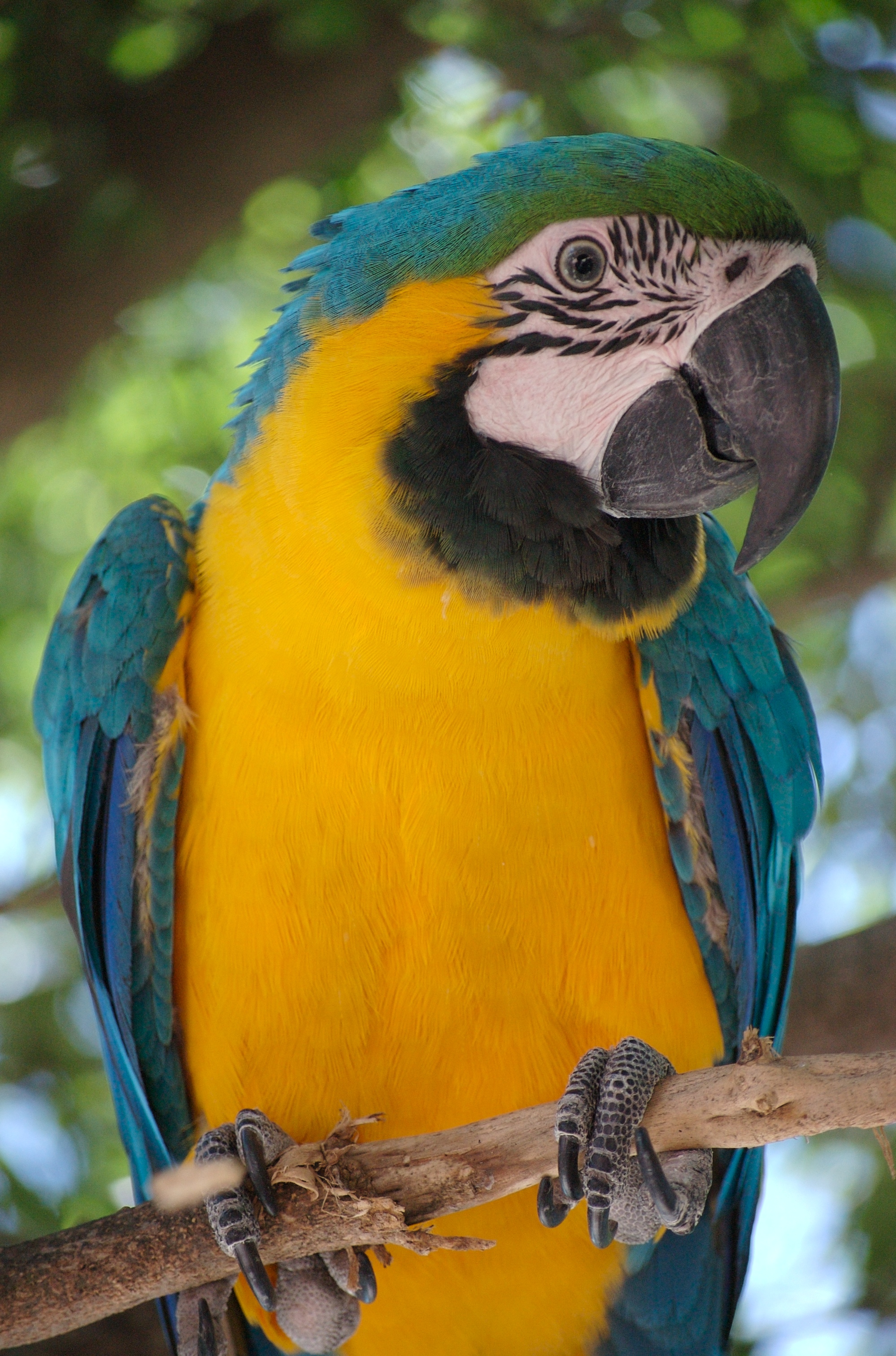- Blue-and-yellow Macaw
Taxobox
name = Blue-and-yellow Macaw

image_caption =
image_width = 210px
status = LC
status_system = iucn3.1
regnum =Animal ia
phylum =Chordata
classis = Aves
ordo =Psittaciformes
familia =Psittacidae
subfamilia =Psittacinae
tribus =Arini
genus = "Ara"
species = "A. ararauna"
binomial = "Ara ararauna"
binomial_authority = (Linnaeus,1758 )
range_
range_map_caption=The Blue-and-yellow Macaw ("Ara ararauna"), also known as the Blue-and-gold Macaw, is a member of the group of large
Neotropical parrot s known asmacaw s. It breeds in forest (especially varzea, but also in open sections of Terra Firme) and woodland of tropicalSouth America fromTrinidad andVenezuela south toBrazil ,Bolivia , andParaguay . It barely extends intoCentral America , where restricted toPanama . It is an endangered species in Trinidad, has probably beenextirpated from westernEcuador , and is on the verge of being extirpated from Paraguay, but still remains widespread and fairly common in a large part of mainland South America. It is therefore listed asLeast Concern byBirdLife International .Description
It can reach 76-86 cm (29.9-33.9 inches) long and weigh 900 to 1300 g (2-3 lbs), making it one of the biggest parrots in the world. It is vivid in appearance with blue wings and tail, dark blue chin, golden under parts and a green forehead. Its beak is black, and very strong for crushing nuts. The naked face is white, turning pink in excited birds, and lined with small black feathers.
There is little variation in plumage across the range. Some birds have a more orangey or "
butterscotch " underside color, particularly on the breast. This was often seen in Trinidad birds and others of theCaribbean area, and appears to be due to environmental factors.Fact|date=June 2008 The Blue-and-yellow Macaw uses its powerful beak for breaking nutshells, and also for climbing up and hanging from trees.Breeding
The Blue-and-yellow Macaw generally mates for life. It nests in a tree hole and the female typically lays two or three eggs. The female incubates the eggs for about 28 days, and the chicks
fledge from the nest about 90 days after hatching.cite book |first = David| last = Alderton | title = The ultimate encyclopedia of caged and aviary birds | isbn = 184309164X |pages= p. 235| publisher = Hermes House |location = London, England | year = 2003]Aviculture
Blue-and-yellow Macaws are popular as
pet s partly because of their striking appearance and ability as atalking bird ; however, the price of a single bird may be in excess of (USD) $1,000-$2,000 in North America and their large size makes accommodation problematic.They require much more effort and knowledge from owners than more traditional pets such as dogs or cats. They are intelligent and social, so for someone who can provide for their needs, they make good and loving
companion parrot . Blue-and-yellow Macaws are known to their owners as more of a "one person" bird, and bond very closely to their owners. They tend to be more aggressive during mating season, typically 6-8 weeks in the spring time.Fact|date=June 2008Even the most well cared for Blue-and-yellow Macaw will "scream" and make other loud noises, nonetheless, it is possible to make them silent.Fact|date=June 2008 Loud vocalizations, especially "flock calls", and destructive chewing are natural parts of their behavior and should be expected in captivity.
They require a varied diet, a seed only diet will lead to health problems such as vitamin deficiency. An example of a good diet would be a quality pelleted mix, in conjunction with a mix featuring seed, nuts, and
dried fruit s, with fresh vegetables (greens and roots) and fruits fed regularly; furthermore, it is quite common (and appreciated by the parrot) to partake with their human owners of safe foods like pasta, bread, etc.It is important to avoid foods with high fat content (generally) while striving to provide a wide variety of foods. There are some foods which are toxic to birds and parrots as a group.
Cherry and most otherRosaceae pits and seed,avocado s,chocolate , andcaffeine are among the foodstoxic to parrots. Chocolate and caffeine are not metabolized by birds the same way they are in humans, Sacerdotal seed containcyanogenic glycoside s and avocados containpersin which are both toxic compounds to birds.The Blue and Yellow Macaws safe food to eat is oranges, apples, Grapes, peanuts, walnuts and sunflower seeds.Gallery
References
* Database entry includes justification for why this species is of least concern
* (1994): "My parrot, my friend : an owner's guide to parrot behavior". Howell Book House, New York. ISBN 0-87605-970-1
* (1991): "A guide to the birds of Trinidad and Tobago" (2nd edition). Comstock Publishing, Ithaca, N.Y.. ISBN 0-8014-9792-2
* (2003): "Birds of Venezuela". Christopher Helm, London. ISBN 0-7136-6418-5External links
* [http://www.biodiversitylibrary.org/name/Ara_ararauna View occurrences of "Ara ararauna"] in the Biodiversity Heritage Library
* [http://www.cityparrots.org City Parrots]
* [http://www.worldparrottrust.org/publications/parrotportfolio.htm The Parrot World Trust]
* [http://ibc.hbw.com/ibc/phtml/especie.phtml?idEspecie=2234 Blue-and-yellow Macaw videos] on the Internet Bird Collection.
* [http://www.pbase.com/image/19441222 Image on PBase]
Wikimedia Foundation. 2010.
